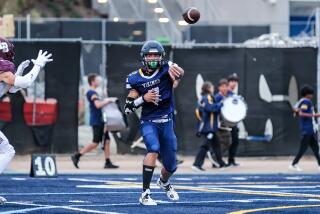Picking Up THE Pieces : Will Cal State Long Beach Ever Be Able to Revive Its Football Program at a Less Costly Level?
- Share via
The demise of the Division I-A football team at Cal State Long Beach did not surprise former athletic director John Kasser, but he predicted that the 49ers will be back on the field again, perhaps as early as 1993.
After five seasons of struggling to win games and keep the program afloat financially, Long Beach President Curtis L. McCray announced last week that he was eliminating the program with the hope of bringing it back at a lower, less costly level.
Kasser, now the athletic director at UC Santa Barbara, thinks the 49ers can start over by joining the Western Football Conference, a Division II alignment that is expected to move up to Division I-AA status.
“For all intents and purposes, (Division I-A) football died in 1986,” Kasser said.
Sacramento State, Cal Poly San Luis Obispo, Cal State Northridge, Santa Clara and St. Mary’s have already agreed to play I-AA football in the WFC, Kasser said. Southern Utah, UC Davis and Santa Barbara are expected to vote on it in early 1992. The University of San Diego and Cal State Fullerton, which will have a new football stadium in the fall, are also considering membership, Kasser said.
The new league would meet McCray’s call for a less costly way to offer a football program, Kasser said. He said Santa Barbara expects to spend only $500,000 a year on its football team if it joins the WFC. Conference schools would not be allowed to give more than five scholarships a year, or have more than 20 players on scholarship at any time.
Long Beach had 43 players on scholarship and a total budget of $1.3 million when it discontinued funding for the program. The NCAA allows Division I-A schools a maximum of 90 scholarships and has no restrictions on overall budget.
The addition of Long Beach to a revamped WFC would also help solidify interest in the new conference, Kasser insisted.
“Think about it,” he said. “With CS Long Beach, that would give us 10 very good-sized schools and some good competition.”
A cable television deal is being discussed, but reports that the new league eventually would be run by the Big West Conference are unfounded, Kasser said.
In November of 1986, Kasser was told by then Long Beach president Stephen Horn to raise $300,000 in a month or football would be eliminated. With the help of boosters, Kasser raised $25,000 more than Horn ordered. The program had been saved, but it suffered irreparable harm.
Potential recruits were disheartened by the ultimatum. Coach Mike Sheppard then quit on Christmas Eve to take the coaching job at New Mexico, leaving Kasser $140,000 short at the time of the $300,000 goal.
“I was sitting in my office on the day after Christmas thinking to myself, ‘There’s no way I’ll get all of this money in time,’ ” Kasser said. But a flurry of last-second donations satisfied Horn’s demand.
In January, 1987, Kasser appointed assistant Larry Reisbig to replace Sheppard, but the relatively unknown Reisbig, whose only previous experience as a head coach had been at two community colleges, was unable to turn around the program.
Kasser resigned later that winter to take a position with the College Football Assn.
Kasser credited McCray with making a tough, yet warranted, decision. He predicted that the state’s severe budget crisis may force other schools to follow the lead set by Long Beach.
“There are other institutions that will have to stand up, take a look at football and then make the decision that Long Beach did,” he said.
At UC Santa Barbara, students will be asked to approve a referendum on a fee increase in February that will provide most of the funding for football.
“I’m not going to get caught up in raising all that money this time,” Kasser said.
But, with a smile, Kasser pointed out that on the wall of his UC Santa Barbara office is a photograph of himself handing Horn a $325,000 check.
More to Read
Go beyond the scoreboard
Get the latest on L.A.'s teams in the daily Sports Report newsletter.
You may occasionally receive promotional content from the Los Angeles Times.










